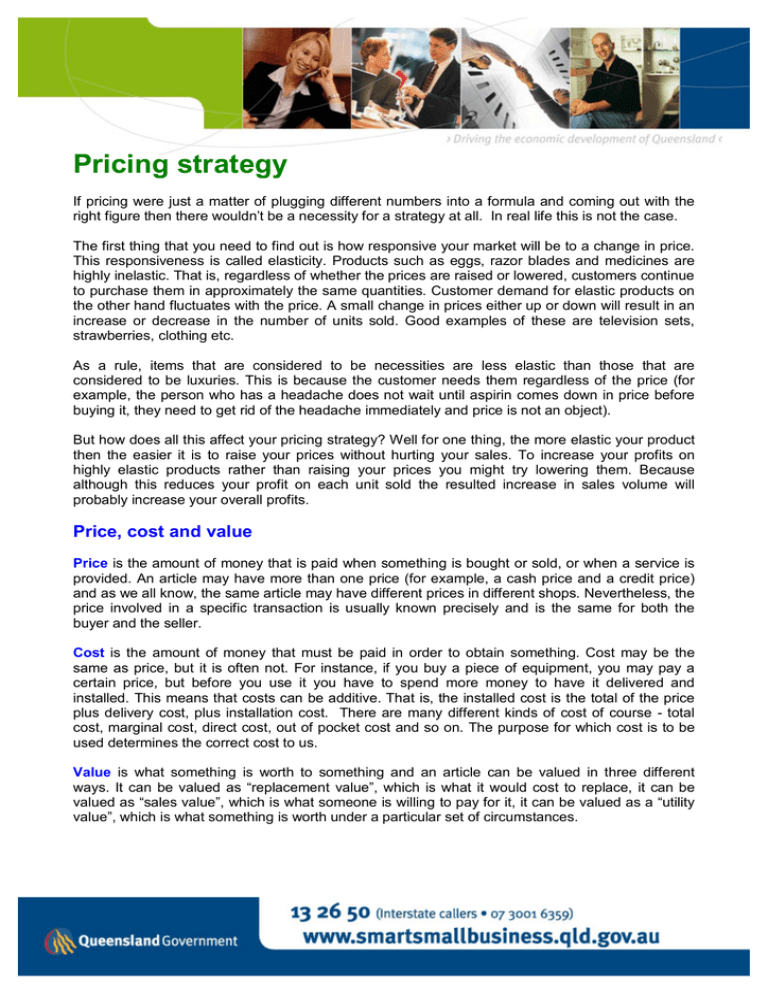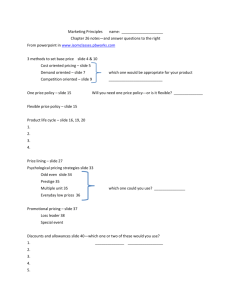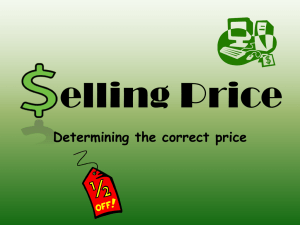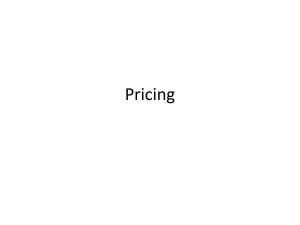Pricing Strategy: Cost, Demand, & Competition
advertisement

Pricing strategy If pricing were just a matter of plugging different numbers into a formula and coming out with the right figure then there wouldn’t be a necessity for a strategy at all. In real life this is not the case. The first thing that you need to find out is how responsive your market will be to a change in price. This responsiveness is called elasticity. Products such as eggs, razor blades and medicines are highly inelastic. That is, regardless of whether the prices are raised or lowered, customers continue to purchase them in approximately the same quantities. Customer demand for elastic products on the other hand fluctuates with the price. A small change in prices either up or down will result in an increase or decrease in the number of units sold. Good examples of these are television sets, strawberries, clothing etc. As a rule, items that are considered to be necessities are less elastic than those that are considered to be luxuries. This is because the customer needs them regardless of the price (for example, the person who has a headache does not wait until aspirin comes down in price before buying it, they need to get rid of the headache immediately and price is not an object). But how does all this affect your pricing strategy? Well for one thing, the more elastic your product then the easier it is to raise your prices without hurting your sales. To increase your profits on highly elastic products rather than raising your prices you might try lowering them. Because although this reduces your profit on each unit sold the resulted increase in sales volume will probably increase your overall profits. Price, cost and value Price is the amount of money that is paid when something is bought or sold, or when a service is provided. An article may have more than one price (for example, a cash price and a credit price) and as we all know, the same article may have different prices in different shops. Nevertheless, the price involved in a specific transaction is usually known precisely and is the same for both the buyer and the seller. Cost is the amount of money that must be paid in order to obtain something. Cost may be the same as price, but it is often not. For instance, if you buy a piece of equipment, you may pay a certain price, but before you use it you have to spend more money to have it delivered and installed. This means that costs can be additive. That is, the installed cost is the total of the price plus delivery cost, plus installation cost. There are many different kinds of cost of course - total cost, marginal cost, direct cost, out of pocket cost and so on. The purpose for which cost is to be used determines the correct cost to us. Value is what something is worth to something and an article can be valued in three different ways. It can be valued as “replacement value”, which is what it would cost to replace, it can be valued as “sales value”, which is what someone is willing to pay for it, it can be valued as a “utility value”, which is what something is worth under a particular set of circumstances. Avoid pricing mistakes • • • • • Pricing is too cost oriented. Companies do not take enough account of the overall market demand and consumer psychology. Prices are not revised often enough to take advantage of changed conditions in the marketplace. Prices are set independently of the rest of the marketing plan. Prices are not varied enough for different product items and market segments. Prices are set to match or better a competitor without justification or analysis. 3 types of pricing strategies The best strategy for you will depend on your firm, your product and your market. Remember that you do not have to use just one of the strategies outlined above. Many firms, in fact, use more than one approach and arrive at a price that represents a reasonable compromise between each of these strategies. 1. Cost oriented pricing: Many firms set product prices largely on the basis of product cost. The price to the distributor of an item will therefore be the units total cost plus an amount to cover a targeted profit on the unit. Simple cost plus methods of pricing can be used most effectively in well-established businesses in a stable market environment. 2. Demand oriented pricing: One obvious disadvantage of at least the target-pricing component of cost-based pricing is that sales volume is affected by price. What is missing is a demand function showing how many units the firm could expect to sell at different prices. It is very difficult to quantify how much a price increase or decrease will affect demand. This relationship is called the price elasticity of demand and differs between products. Another approach to pricing is to work backwards from the products perceived value to the buyer, rather than forward from costs. A company develops a product for a particular target market with price, quality and service to match the competition for that segment of the market. Having determined this demand oriented price, the manufacturer then works out whether, allowing for costs, there is sufficient profit on the item to make it worthwhile. There is no formula for working out sales volume at the demand price. This figure has to be arrived at on the basis of experience and a conservative estimate of the market share the product will receive. 3. Competition oriented pricing: Using this strategy a firm relates its prices to those of competitors rather than to cost or demand. It is not necessary to charge the same price as the competition because prices may be lower or higher by whatever percentage one wants. In an industry where products are not very different, competition oriented pricing takes the form of the going rate pricing, that is, most firms charge a similar price for much the same product. This price level reflects costs and a fair rate of return. Further information The following fact sheets provide further information on these issues: • • Increase your sales Marketing plan






